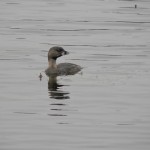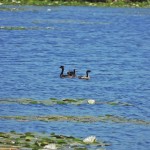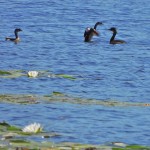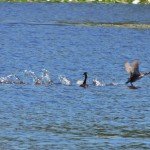23 July 2015. Morriston ON. There is a pond in this once-quaint village, which I intend to visit every spring but never seem to get around to doing so. Pied-billed Grebes nest there; I’m sure of it. On the two occasions I’ve visited it in late summer, I’ve seen a small group of them paddling around. I really must make the effort next April.
It’s not the visuals of Pied-billed Grebes that attract me; they look like waterlogged chickens, it’s their maniacal almost depraved spring territorial ‘song’. Variously described as: “ …a series of cooing notes… run into slower paced, gulping clucks that can fade away” (National Geographic); or according to Pete Dunne “…a loud wild-sounding keening that incorporates bleating coos and mournful wails…. Like someone blowing a satisfying series of toots into a handkerchief.” (click here for more on Pete Dunne). It’s on my things-to-do list to be visual and auditory witness to this performance. I’ve mentally ear-marked this pond as a best bet.
Unlike the village in general whose heart has been severed by a very busy arterial road and is now just a rather grubby, traffic-light controlled chasm; the pond is a pretty place and worth a diversion from the road race. No doubt a post-glacial kettle lake it would, in the normal course of things, be a rather static body of water. But, flanked by pricey homes it has been beautified to fulfill residents’ expectations of a village pond. It has a couple of small docks suitable for after-dinner dreaming, a spraying fountain and expanses of white water lilies. It can be a good place to watch Great Blue and Green Herons as I noted in an earlier post. (click here to read it)
I stopped there in the middle of the day today and sure enough there were four Pied Billed Grebes; two adults and I assume two chicks. They kept their distance as they always do. So, with my limited camera power, I was unable to get any really good shots but here’s a few rather long-distance shots from today and one taken elsewhere in late winter and which may help illustrate why I describe them as looking like waterlogged chickens.
(Visible only on the website, not if you’re reading this as an email.)



